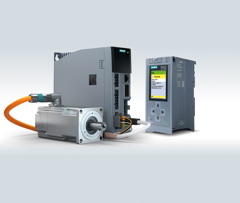Siemens Launches Servo Drive
- Published: May 01, 2018
ELK GROVE VILLAGE, IL | Siemens announces the Sinamics S210 converter designed specifically for use with the newly developed Simotics S-1FK2 motors. Company says the new servo drive system is available in an initial offering from 50–750 watts. The converters come with integrated safety functions and reportedly enable rapid engineering via motion technology objects in Simatic S7-1500 controllers. They are connected to higher-level controllers via Profinet and are said to be quickly and easily programmed by automatic motor parameterization and one-button tuning. Typical uses for this new drive system include packaging machines, handling applications such as pick-and-place, wood and plastics processing, as well as life sciences and digital printing. 
“The Sinamics S210 focuses on highly dynamic motor axis control, while the connected controller, for example the Simatic S7-1500 or S7-1500T with its extended motion control functionality, takes complete charge of positioning functions for the connected drive axes,” says Craig Nelson, product manager for Sinamics S-series drives.
The Sinamics S210 is commissioned using an integrated web server. One-button tuning functionality allows automatic optimization of control parameters, taking into consideration the behavior of the connected mechanics by different dynamic levels.
Integrated safety functions include STO (Safe Torque Off) and SS1 (Safe Stop 1). Both can be actuated using Profisafe, STO additionally using a terminal. In conjunction with the rapid sampling and smart control algorithms of the Sinamics S210, a high-grade encoder system on the Simotics 1FK2 motor and the combination of low rotor inertia and high overload capability allow the servomotors to achieve outstanding dynamic performance and precision, says company.
Simotics 1FK2 motors are connected to the converters using a “One Cable Connection” (OCC), which includes the power conductors, encoder signal, and brake—all grouped together in a thin cable measuring just 9 mm in dia. Its minimal cross-section makes the OCC cable thinner, lighter, and more flexible than previous power cables, reports company, considerably simplifying the cabling process. This results in a single motor plug connector and connection at the converter is just as simple with user-friendly plugs with push-in terminals on the front.













